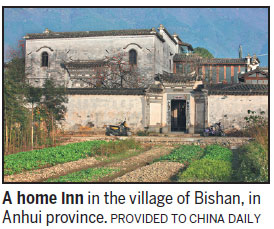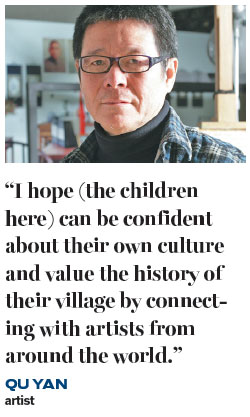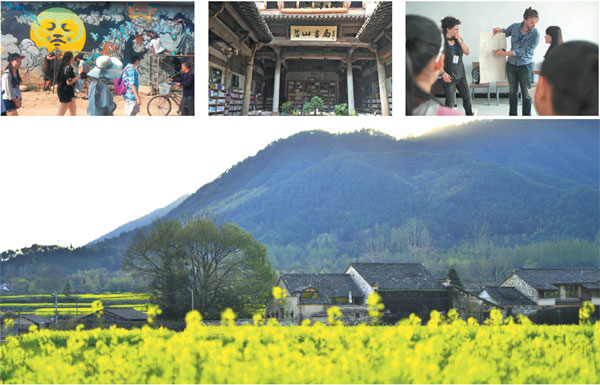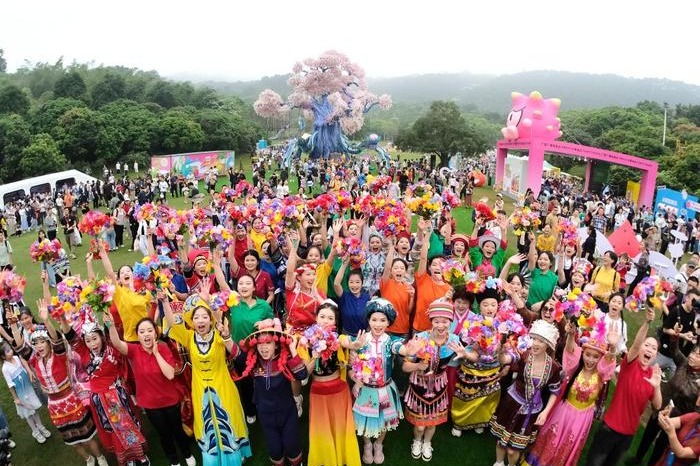The art of rural revival

As Wang Shouchang sits sipping from a coffee cup, he revels in a photo book on Hui-style architecture. Behind him on bookshelves sit One Hundred Years of Solitude by Gabriel Garcia Marquez and The Moon and Sixpence by Somerset Maugham, among many other books, and beyond the walls, in the distance, with mountains covered in mist, a cow earns its daily keep in the rice fields.
The 200-year-old ancestral hall in the village of Bishan, in Anhui province, in which Wang is sitting serves now as an art bookshop.
"We were all a bit dubious about how this would go when it opened three years ago," says Wang, 71, a local who works for the bookshop, whose selection includes works on architecture, art, history and literature.
| Clockwise from top left: A muralpainting event in Xu village; an art bookshop in Bishan village that used to be the village's ancestral hall; artists from Australia teach painting in Xu village; the landscape of Bishan village. Photos Provided to China Daily |
"On weekends, many people from nearby towns and cities come here to buy books because they can't find what we have elsewhere."
The village, nestling at the foot of Bishan Mountain, is a drive of more than an hour from the nearest city, Huangshan, and for those who need to rely on public transportation, getting to the village can be a hassle, with a commuter bus passing through just twice a day.
Yet the bookstore has become a cultural watering hole, and villagers are the ones who draw most readily from it, Wang says. It regularly holds activities such as "poetry parties", art exhibitions and lectures by writers. For locals whose daily routine consists of farming and raising silkworms, these activities offer something "fresh with an urban taste", Wang says.
The bookshop that was once a temple is part of a rural development project initiated by Ou Ning, an artist and curator who moved to the village in 2011, keen to revive the countryside through culture and art.
Next to the bookshop is a coffee bar that used to be a cowshed, and several blocks away is an old rice store that is now a showroom displaying artisanal clothes and bamboo products.
Over the past few years the village, once inhabited mainly by the elderly and children, has attracted academics, architects, artists, From page 1 designers, musicians and scholars from China and other countries, many of them invited by Ou, to take part in activities including giving lectures or performances.
"There is a trend in China for urban elites, especially artists, to go to the countryside and help revive it, mostly culturally," says Li Huadong, an expert on rural development in China at the Beijing University of Technology.

In 2005, the central government began to strongly advocate rural revival as countless villages across the country lost a great chunk of their soul, the urban exodus leaving many of them with rump populations consisting mainly of elderly folk looking after their grandchildren. Artists such as Ou then decided to see whether they could create a prototype for how parts of rural China could reinvigorate themselves in novel ways.
"For these urban elites, this was all very new," Li says. "In fact, rural development lies very much at China's roots, but anyone who crosses a river needs to feel the stones."
Qu Yan, an artist who works with installations, paintings, photos and videos, decided to use the power of art to help revive Xu village in Shanxi province, something he sees as "an artist's responsibility" as he reflects on the state of China's culture following the economic successes the country has notched up over the past 30 years or so.
When Qu was on an artistic scouting mission in 2007, taking photos, he was attracted by the houses of various dynasties in Xu village, in the foothills of Taihang Mountain. In 2011 he put on an international art festival in the picturesque village, inviting artists from 25 countries to display works there.
At the time, the village was a shadow of its former self, most of its adults having gone off to pursue brighter prospects in the city.
Qu and his team helped renovate old houses dating back to the Ming Dynasty (1368-1644) and transformed a rice storehouse into an art museum to display works made by artists taking part in the art festival. During the festival artists stayed in the homes of villagers.
"Locals didn't dare talk with these foreign artists," Qu, 62, says. "But now they can communicate with each other, their children acting as interpreters."
During summer holidays, Qu invites NGOs to teach English in the village and musicians to teach children the piano, an instrument many of them will not have seen before.
"The children here are much more confident than when I first came here," he says. "I hope they can be confident about their own culture and value the history of their village by connecting with artists from around the world."
With old houses having been renovated and art festivals being regular fare, Xu village has attracted many art students who go there to create works, and travelers who are interested in art as well.

In fact, adults who had abandoned the village for the city are now making the homeward journey and staying to make the most of work and business opportunities, such as setting up homestay establishments or running inns.
The core of rural development is restoring the respect of villagers for their forebears, Qu says. He encourages villagers to take out genealogical books often hidden under a bed and put them on display in their sitting room.
Sun Jun, a painter, promoted a similar idea when he helped revive Haotang village in Henan province from 2011.
Haotang, which many now regard as one of the most beautiful villages in China, has a clean river running through it and rows of two-story courtyard houses - complete with sitting rooms in which the owner has laid out books displaying family genealogy.
"We encourage them to do this so they know who they are and where they come from," Sun says. Villagers once had a tradition of valuing their ancestors, but in the frenetic din of modernization they threw this away, he says.
He recalls his first impression of Haotang, a remote village without traditional houses and ancient history: shock at the state of the river and its filthy roads.
"For three months my team and I cleaned up rubbish, and then the locals joined in with us," Sun says.
Next he came up with new designs for villagers' flats, something they resisted for a long time.
"People want to live in beautiful apartments like those in cities. Somehow they regard houses with ceramic-tiled walls as attractive," Sun says.
Hao Pengcheng's home was one of the first transformed into a two-story courtyard house with red walls and gray-tiled roof. He had bought an apartment in the city of Xinyang, a drive of about two hours from the village, and ran a dry-cleaning business there.
"I and many villagers disagreed with Sun over his rebuilding plans," says Hao, who gave up his apartment and returned to his hometown.
"Now I'm really happy with what has been done," he says.
Hao, 37, says that once Sun explained the cultural significance of the colors of the wall and tiles, for which he gained inspiration from traditional architecture in Henan, he understood what it was all about.
Hao has fruit trees in the courtyard and tea trees in the backyard, key commercial activities in the village.
He has a son and daughter, both of whom attend the village school, whose enrollment has swelled from just 50 students in 2011 to about 200 now.
"The whole village is full of life and, like me, many of those who moved away to cities have come back home," Hao says
Far from the sorry sight that Sun found when he first went to the village six years ago, it now has bookshops, teahouses, an exhibition center and temples. Many traditional festivals and rituals have been restored and this attracts tourists, he says.
"It is critical in rural development to restore lifestyle, culture and history, which have been strongly compromised by modernization," Sun says.
(China Daily European Weekly 07/28/2017 page1)
Today's Top News
- Xi to attend 2nd China-Central Asia Summit in Kazakhstan on June 16-18
- Xi extends condolences to King Charles III over plane crash in India
- Xi extends condolences to Indian leaders over plane crash
- Israel launches attack on Iran's nuclear sites
- Israel conducts preemptive strike on Iran
- The bumpy road of international trade































